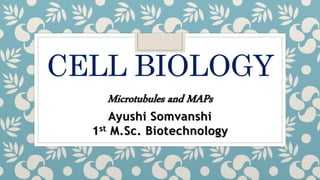
Cell biology.
- 1. CELL BIOLOGY Microtubules and MAPs Ayushi Somvanshi 1st M.Sc. Biotechnology
- 2. MICROTUBULES ◦ The microtubules are found in the cytoplasmic matrix of all eukaryotic cells. They also occur in cilia, flagella , centrioles and basal bodies , mitotic apparatus etc. ◦ Prokaryotic cells lack microtubules. ◦ The microtubules are hollow , unbranched cylinders, generally about 25nm in diameter with a hollow core of about 15nm. ◦ The boundary of a microtubule is composed of 13 parallel protofilaments. Each protofilament is made up of and subunits of tubulin protein (non contractile protein). ◦ The assembly and disassembly of microtubules require GTP and Ca+2
- 3. ◦ Straight, hollow cylinders are found throughout the cytoplasm of all eukaryotic cells (prokaryotes don't have them) and carry out a variety of functions, ranging from transport to structural support. ◦ Are the major components of cilia and flagella, and participate in the formation of spindle fibres during cell division (mitosis). ◦ The length of microtubules in the cell varies between 200 nanometres and 25 micrometres, depending upon the task of a particular microtubule and the state of the cell's life cycle.
- 5. ◦ Function 1. These help in the spindles and astral rays formation during cell division. 2. These form the cytoskeleton of cilia and flagella . 3. These help in generating the shape , rigidity and form of the cell and cell motility. 4. Microtubules help in the anaphasic movement of chromosomes. 5. Microtubules help in the intracellular transport of nutrients and inorganic ions. 6. Position of future cell plate is determined by microtubules.
- 6. "Building blocks" of microtubules – tubulins ◦ All eukaryotic cells produce the protein tubulin, in the usual way. ◦ The usual way, of course, is by transcription of genes coding for tubulin to produce messenger RNA, followed by the translation of mRNA by the ribosomes in order to produce protein. ◦ Cells maintain at least two types of tubulin, which we call alpha tubulin and beta tubulin. However, it is doubtful that the two types can found in cells as individual proteins.
- 7. ◦ Alpha and beta tubulin spontaneously bind one another to form a functional subunit that we call a heterodimer. ◦ A heterodimer is a protein that consists of two different gene products. The term is entirely descriptive - the prefix hetero- means "different," the prefix di- means "two," and the suffix -mer refers to a unit, in this case a single polypeptide. ◦ Obviously, cells do not continue to make tubulin (or any other protein) until they run out of resources. ◦ Some process must regulate the synthesis of tubulin. A common regulatory mechanism is feedback inhibition.
- 8. ◦ When intracellular conditions favor assembly, tubulin heterodimers assemble into linear protofilaments. Protofilaments in turn assemble into microtubules. All such assembly is subject to regulation by the cell. ◦ Microtubules form a framework for structures such as the spindle apparatus that appears during cell division, or the whip like organelles known as cilia and flagella. Cilia and flagella are the most well- studied models for microtubule structure and assembly, and are often used by textbooks to introduce microtubules
- 9. Dynamic instability of microtubules: ◦ Dynamic instability refers to the coexistence of assembly and disassembly at the (+) end of a microtubule. The microtubule can switch between the growing and shrinking phases dynamically at this region. ◦ Under steady state conditions a microtubule may appear to be completely stable, however there is action taking place constantly. Populations of microtubules usually consist of some that are shrinking and some that are growing. A single microtubule can oscillate between growth and shortening phases. During growth, heterodimers are added on to the end of a microtubule, and during shrinkage they come off as intact subunits. The same heterodimer can come off and go back on. ◦ Since even apparently stable micro tubular structures have an intrinsic instability, they are considered to be in a dynamic equilibrium, or steady state.
- 11. Microtubule-associated proteins (MAPs) ◦ These are proteins that interact with the microtubules of the cellular cytoskeleton. ◦ Function: ◦ A number of different MAPs can function to either stabilize microtubules to promote their polymerization or inhibit their depolymerisation. ◦ MAPs bind to the tubulin subunits that make up microtubules to regulate their stability. ◦ A large variety of MAPs have been identified in many different cell types, and they have been found to carry out a wide range of functions. ◦ These include both stabilizing and destabilizing microtubules, guiding microtubules towards specific cellular locations, cross-linking microtubules and mediating the interactions of microtubules with other proteins in the cell.
- 12. ◦ Within the cell, MAPs bind directly to the tubulin dimers of microtubules. ◦ This binding can occur with either polymerized or depolymerized tubulin, and in most cases leads to the stabilization of microtubule structure, further encouraging polymerization. ◦ Usually, it is the C-terminal domain of the MAP that interacts with tubulin, while the N-terminal domain can bind with cellular vesicles, intermediate filaments or other microtubules.
- 13. ◦ MAP-microtubule binding is regulated through MAP phosphorylation. ◦ This is accomplished through the function of the microtubule-affinity- regulating-kinase (MARK) protein. ◦ Phosphorylation of the MAP by the MARK causes the MAP to detach from any bound microtubules. ◦ This detachment is usually associated with a destabilization of the microtubule causing it to fall apart. ◦ In this way the stabilization of microtubules by MAPs is regulated within the cell through phosphorylation.